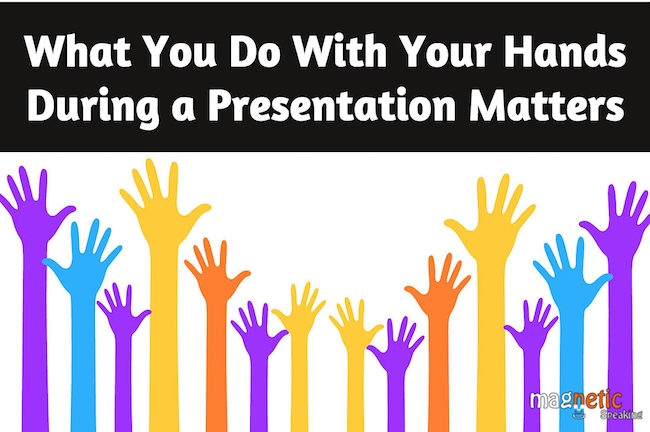You are always talking with your hands.
Unfortunately, your hands might be saying the wrong things.
According to a study published in the Leadership & Organization Development Journal: If you don’t use your hands when presenting, or if you use awkward hand movements, your audience will label you as cold and aloof.
On the contrary, if you use proper hand gestures, they will perceive you as engaging and charismatic.
Because hand gestures are so important to your success as a presenter, I came up with the following list called the 5 Talking With Your Hands Rules.
Note: Of course there are exceptions to all these commandments. The most notable exception is when you consciously violate these commandments to demonstrate a point.
Hand gestures warning: What you do and don’t do with your hands determine how you are perceived by your audience.
Talking With Your Hands Rule #1: Thou Shalt Not Leave Hands Idle:
Imagine watching a speaker for an hour just flapping his lips with no hand movement. That would be weird, if not plain freaky!
When you move your hands to explain what you are talking about, you will help your audience understand your points. A study by the University of Chicago showed that What a speaker does with her hands as she gestures facilitates understanding of audience members.
If you don’t use your hands, your audience will judge you as a less charismatic leader, and they will not understand as much of your presentation.
So make sure you use your hands when you speak. Get comfortable using your hands to drive home each point you make to your audience.
Talking With Your Hands Rule #2: Thou Shalt Not Put “Both” Hands in Pockets with “thumbs out:”
Notice that I said no to both hands. Because in some cases putting one hand in a pocket looks great and will invoke a sense of confidence.
A client of mine once complained that he is not closing sales because he is intimidating customers during sales presentations. After seeing him present, I agreed. I advised him to put only one hand in his pocket while presenting.
That had an enormous impact on him: that simple move made him look more approachable and more confident. He started getting more interaction with his customers during presentations and more sales.
The one hand in pocket approach might not work for everyone. Only use this if you have an intimidating presence. Otherwise, just keep both hands out of pockets and talk with your hands.
You may place one hand in your pocket because that can demonstrate that you are relaxed and comfortable while still having authority. However, both hands in your front or back pocket will always indicate a lack of professionalism. So avoid putting both hands in your pockets at all times.
Talking With Your Hands Rule #3: Thou Shalt Not Cross Arms “All the Time.”

As a speaker, open body language makes you more approachable and closed body language makes you less approachable.
Growing up, I always noticed that when my dad was upset and did not want us to talk to him, he crossed his arms and sat on the couch. No one in the family dared to speak to him. You have probably had similar experiences with parents growing up.
As a result, I am conditioned to worry when I see people with crossed arms, and most likely, so are you.
Yes, I agree that we should be more enlightened and not read too much into other’s behavior. But we are all humans, and we can’t help it. Now as a speaker, you need to be aware of how your body language affects others reactions and remove anything that might distract them from your message.
Try not to fold your arms even if you are thinking or waiting for a speaker. If you catch yourself with folded arms, just open them up, and soon you will pick up a habit of maintaining open body language.
Talking With Your Hands Rule #4: Thou Shalt Not Wring Hands:

Wringing your hands gives the impression that you are nervous, hesitant and worried about the words you are saying.
There are many forms of wringing:
1. Clasped hands wringing

That’s when you hold hands together palm-to-palm and move them back and forth.
2. Cupped hands wringing

That’s when you cup your hands inside of each other palm-to-back, and you move them nervously.
3. Intertwined finger wringing

That’s when you twist your fingers and rub your hands back and forth.
Instead of hand-wringing, you can use “hand steepling.” Steepling hands are perceived as confident, calm, and smart. Just like any other technique, don’t overuse it.

Steepling your fingers is just an intermediate state for you until your hands begin moving naturally again with the conversation.
Talking With Your Hands Rule #5: Thou Shalt Not Fake Hand Gestures:
The worst thing you can do with your hands is to fake gesture. Your audience is starving nowadays for authenticity and any attempt you make to faking anything will backfire.
I always recommend that clients practice fake gesturing in private to get comfortable with new movements. However, when it’s performance time, I tell them to let go and be authentic. If they practiced enough in practice, the gestures would come out naturally and authentically when they are speaking publicly.
What to do now
I know I just gave you a comprehensive list of what not to do. But then what do you do?
Here is a list of three things to do to improve your gestures when presenting.
1. Awareness: pay attention to what you are doing with your hands.
2. Replacement: Any time you notice a gesture that you don’t like pull your hands to your side.
3. Be all in: Once your hands are to your side, go to your topic. If you are telling a story, re-live it. If you are talking about a computer code, then visualize the code, and if you are talking about neurons, visualize the neurons in front of you as you talk about them. At the Magnetic Delivery Boot Camp, we have a whole segment on what to do with your hands, what we covered here is just a starter.
Conclusion
You are always talking with your hands.
Unfortunately, your hands might be saying the wrong things.
Your hand gestures can turn off your audience, or they can bring them closer. Five negative gestures impact your credibility and influence, and you should avoid them as much as you can:
Hand gestures to avoid
- Idle hands
- both hands in pockets at all times
- crossing arms
- hand-wringing
- and fake gestures.





